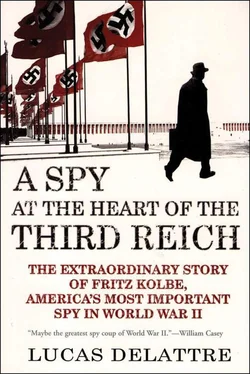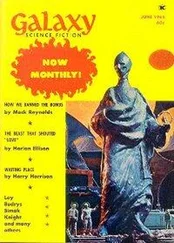decline; quite the contrary: Once again, the documents were sent on paper. Apparently, Fritz had not yet mastered the operation of the camera.
vicinity of St. Valentin: “Lower Danube”: perhaps the Zipf camp, an annex of Mauthausen.
days at the outside: Boston documents nos. 339 and 360. These documents were transmitted to President Roosevelt and to the Joint Chiefs of Staff. Memorandum for the President, July 10, 1944, microfilm (entry 190c, MF1642, roll 18). In The Secret Surrender (p. 29), Dulles writes: “He turned in to us some of the best technical and tactical information on the V-weapons.”
enter the production phase: Boston documents nos. 341 and 607. These details were also transmitted to President Roosevelt and to the Joint Chiefs of Staff. The site in Kahla where the Me-262 plane was to be built, was an old mine (See Chapter 9, note 29).
to have been untouched: Boston document no. 380.
were to be executed: Several documents mention this story—for example, “The Story of George”; also “The Spy the Nazis Missed”; and the biographical document by Gerald Mayer and Fritz Kolbe. According to Edward P. Morgan, Maria Fritsch intentionally failed to inform Fritz of the meeting out of fear of the danger.
world and of history: Henning von Tresckow, speaking shortly before the assassination attempt, quoted in Michael Burleigh, The Third Reich: A New History (New York: Hill and Wang, 2000), p. 716.
silence scorn its leaders: Albert Camus, editorial of August 24, 1944, in Camus à Combat. Éditoriaux et articles d’Albert Camus, 1944–1947 (Paris, Gallimard, 2002).
decision had been ratified: Foreign Ministry, Fritz Kolbe file, official document sent by the ministry to the NSDAP on March 30, 1944.
his messages to Bern: Quibble, “Alias George Wood.”
Max de Crinis: Max de Crinis (1889–1945): a neurologist and head of the department of psychiatry in the Charité hospital, he also held a high rank in the SS. He was one of the figures behind the euthanasia program implemented by the Nazi regime against the physically and mentally handicapped (70,000 victims between 1939 and the summer of 1941). He committed suicide by swallowing a cyanide capsule at the end of the war.
and with Professor Gebhardt: Karl Gebhardt (1897–1948) was one of the most honored doctors in the Nazi regime and held a high position in the SS. He was head of a hospital in Hohenlychen, about one hundred kilometers north of Berlin, where he carried out sinister experiments, such as tests with sulfonamides, on inmates of the nearby camp of Ravensbrück. Sentenced to death by an American military tribunal after the war, he was executed on June 2, 1948. He was a former student of Professor Sauerbruch, with whom he was in regular contact.
that followed the attempt: Unpublished notebooks of Adolphe Jung. Frank and Marie-Christine Jung collection, Strasbourg.
events of July 20: Wilhelm Hoegner had been the prosecutor in Hitler’s trial after the failed Munich putsch of 1923. He had been living in exile in Switzerland since the early years of Nazism.
dated August 8, 1944: R. Harris Smith, OSS, The Secret History of America’s First Central Intelligence Agency (Berkeley: University of California Press, 1972), p. 221.
finish off the job: From Hitler’s Doorstep, p. 358.
now the Communist group: Ibid., p. 360.
to work with Volksmiliz: Kappa message, August 18, 1944.
in on the secret: Letter of August 14, 1944 to Ernst Kocherthaler, National Archives.
join in X/2 hours: Undated manuscript note of Ernst Kocherthaler ( Key for Wood ), National Archives.
legality on their side: See Boston document no. 358. The Germans intended to revive politically Édouard Herriot and a few other politicians of the Third Republic.
First Regiment of France: In November 1942, with the end of the unoccupied zone, the scuttling of the French fleet in Toulon, and the dissolution of the Armistice Army, the French Army had only one remaining regiment, christened the First Regiment of France.
his plan had failed: Memorandum of August 22, 1944 sent to the British secret services by Allen Dulles, National Archives.
had the changes been: Bern, National Archives.
spies had become professionals: The OSS hired the best experts from the major universities and law firms of the East Coast. It employed experts from many fields, including psychoanalysts asked to analyze the depths of the German soul, chemists working on sometimes lunatic plans (for example, adding various drugs to Hitler’s food), and even writers, particularly Germans (including Carl Zuckmayer, Franz Neumann, Herbert Marcuse, and Erich Maria Remarque).
and their new hideouts: Letter from Allen Dulles to William Donovan, September 23, 1944, microfilm (MF1642, roll 81), National Archives.
lack of fuel coupons: Letter from Allen Dulles to his wife Clover, December 9, 1942, Allen W. Dulles Papers.
the envoy, Leland Harrison: “This situation did not fail to provoke the diplomats’ jealousy,” according to Cordelia Dodson-Hood, a colleague of Dulles in Bern in 1944 and 1945 (interview in Washington, March 21, 2002).
of the Weimar Republic: Miscellaneous Activities OSS Bern, undated internal document of OSS Bern, National Archives.
the July 20 plot: Hans-Bernd Gisevius, who had returned to Berlin to participate in preparations for the plot, lived underground for six months before returning to Bern with forged Gestapo papers fabricated by the OSS. Bern, National Archives.
“Dulles’s prestige,” Sichel recalls: Interview with Peter Sichel, December 1, 2001, Bordeaux. After the war, Peter Sichel headed the Berlin branch of the CIA (1949–52), later directed CIA operations in Eastern Europe, and then took over the Hong Kong office in 1956.
of narrow self-interest: Joseph Persico, Piercing the Reich (New York: Viking, 1979).
headquarters in East Prussia: This episode has been reconstructed in part on the basis of a letter of October 4 from Fritz Kolbe to Ernst Kocherthaler, National Archives, and the biographical document by Gerald Mayer and Fritz Kolbe.
“like Wilhelm Furtwängler’s”: Letter from Fritz Kolbe to Allen Dulles, June 28, 1962, Allen W. Dulles Papers.
to prescribe fictitious treatments: Fritz Kolbe relied more than once on the complicity of his medical friends. On one occasion, he had Adolphe Jung give him an injection causing a fever so that he could take a few days off to work on the files that he wanted to transmit to the Americans. Morgan, “The Spy the Nazis Missed,” and biographical document by Gerald Mayer and Fritz Kolbe.
of the Ost Ministerium: In the fall of 1944, the Ministry of the Occupied Territories in the East (Reichsministerium für die Besetzten Ostgebiete or Ostministerium, headed by Alfred Rosenberg), was nothing but an empty shell, as most of the territory in question had been retaken by the Red Army.
Читать дальше











